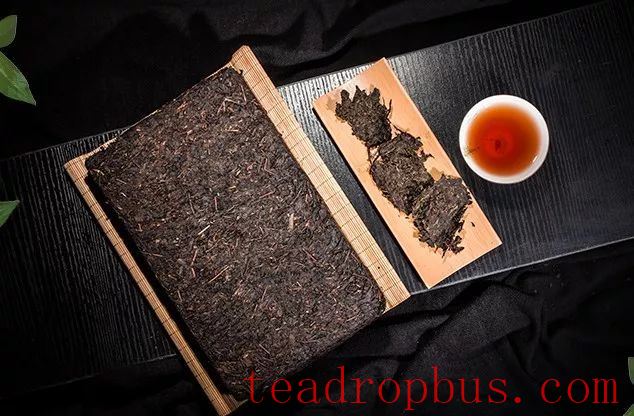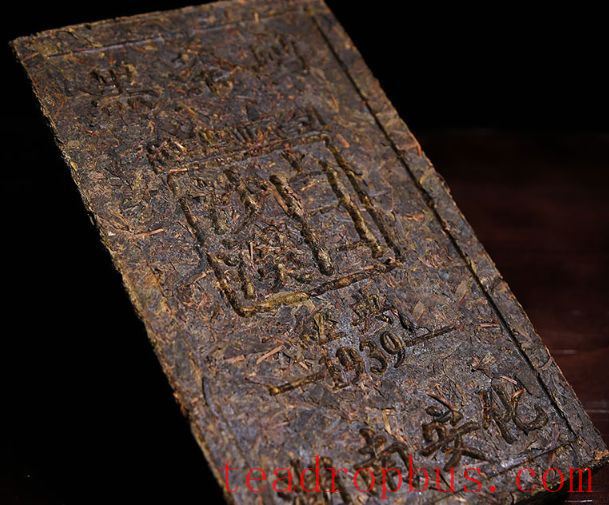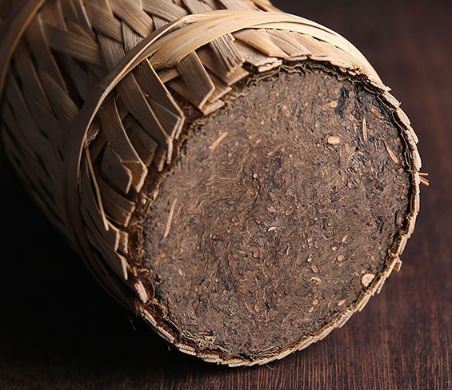Anhua dark Tea comes in many varieties, not only divided into categories like dark brick, Fu brick, flower brick, Tian tip, and Qian bai liang, but also between new and aged teas. Beyond that, teas with different compactness and tenderness still have significant differences. To brew the best flavor, different Anhua dark teas require different brewing methods. Below, we will specifically discuss how to brew various Anhua dark teas.

New Tea
01. New Tea
Slightly Lower Water Temperature, Shorter Steeping Time
The water temperature should be slightly lower, ideally between 90-95°C, to avoid a “cooked” taste. In principle, for teas with strong flavors, use a slightly lower temperature and a shorter steeping time; for lighter teas, do the opposite. Do not pour boiling water directly onto the leaves to prevent cooking the fresh leaves and creating a water-stifled aroma, which affects the freshness of the tea. After pouring out the tea, you can slightly open the lid to cool it down, which can maintain the freshness of the tea.
In terms of utensils, a porcelain Gaiwan is more suitable. Porcelain gaiwans have a fine texture and thick glaze, and do not retain flavors, which are their advantages. In other words, they can truly present the inherent characteristics of the tea, such as its aroma and flavor purity. New Anhua dark tea has a slightly bitter and astringent taste. There's a saying in Anhua: “If it isn't bitter and astringent, it's not tea.” It is recommended to store it for a few years before drinking, as this improves its taste.
02. Dark Brick / Flower Brick Tea
High-Temperature Rinse, Slightly Cooled Water for Brewing
Anhua dark tea, such as dark brick and flower brick teas, are usually very tightly compressed. A high-temperature rinse (boiling water) removes impurities. (Pour boiling water into a sharing pitcher and let it sit naturally for about 30 seconds, or use a controllable hot water pot at 95°C.) Slightly cooled water should be used for brewing. The steeping time should not be too long to avoid bitterness and astringency. For some teas with slightly less fermentation, you can half-open the lid for the first few infusions to maintain the sweetness of the tea and to help dissipate the mature aroma.
Brewing dark tea in a Yixing clay pot can effectively absorb the “pile-fermentation” and other impurities or odd odors. Using a tall and large Yixing clay pot is better for brewing dark tea, such as Jinglan, Qinquan, Gourd, Beauty Shoulder pots, etc.
Aged Tea
01. Fu Brick Tea
Boiling Water Brewing, Appropriate Infusion Time
Relatively speaking, the amount of tea used for Fu tea should be lower than that for dark brick tea, and the brewing water temperature for Fu tea should be slightly higher. For many Fu brick teas, opening the lid between infusions allows the leaves to cool slightly before the next infusion, creating a different experience. Use low-pouring technique, boiling water, and appropriate infusion time.
Aged teas are mostly brewed using a Yixing clay pot, as they need to maintain a high temperature, and Yixing clay pots have good heat retention. They can also be kept warm by “pot pouring” (pouring boiling water over the pot). Gaiwans and similar utensils cannot achieve this due to their structure. If an aged tea has accidentally picked up other odd odors during storage, the double-pore structure of the Yixing clay pot can absorb these odors, giving it a certain “corrective” ability.
02. Dark Brick Tea
High-Temperature Rinse, High-Temperature Brewing
For aged dark brick tea, you can use a low-pouring technique and quick pouring out of the tea, and the root-keeping brewing method (after five infusions, leave a portion of the tea in the cup after pouring out each infusion, then add more water to brew; generally, “keep two pour eight” or “keep half pour half” is used), which increases the number of infusions and regulates the flavor of the tea.

Both gaiwans and Yixing clay pots can be used for brewing. The advantage of using a gaiwan is that it allows for quick pouring out of the tea, avoiding excessive extraction of the contents, which can result in overly concentrated tea resembling soy sauce broth. Due to its material properties, a Yixing clay pot is advantageous for heat retention and temperature control, making the tea soup richer when brewing aged dark brick tea. If conditions permit, you can use a tea kettle for boiling; the resulting aged dark brick tea will have even more flavor!
Compactness Level
01. Highly Compact
Slow Rinse, Quick Pour-Out
Generally, tightly compressed and dense teas require a smaller amount of tea and a slightly higher water temperature. Higher temperatures can fully awaken the tea.
Once tightly compressed teas start to loosen, their dissolution speed will increase rapidly, so the amount of tea used should be relatively small. It's important to control the brewing rhythm, typically starting “tight” and then becoming “loose,” rinsing slowly and pouring out quickly. After several quick pours, you can slow down the pace, allowing the tea to rest. You'll pleasantly find that a great cup of tea is back in your hands.
02. Less Compact
Humidification is Key
For looser teas, gently humidify them before the formal brewing. During formal brewing, extend the steeping time a little longer for each subsequent infusion compared to the previous one, increasing the extension time progressively, to allow the tea soup to release steadily.
Different Tenderness Levels
01. High Tenderness
Focus on “Permeation”
Generally, tender tea brewing focuses on “permeation,” with more permeation and less steeping. This means not covering the lid (of the cup, pot, etc.) during the brewing process to allow the tea aroma to naturally and slowly evaporate. Tender young leaves are easy to over-steep, which can make the aroma less prominent and the taste watery. Therefore, during brewing, there should be more permeation and less steeping, with permeation being the focus.
02. Low Tenderness
Focus on “Steeping”
Coarser and older Huajuan teas have a thick, hard, and crisp texture. Brewing should focus on “steeping,” with more steeping and less permeation. Use a combination of high temperature and steeping to force out the “coarse and old” aroma. By maintaining a certain temperature, the aroma of the tea can be developed, making the tea taste sweet, mellow, and not dull.

When it comes to brewing tea, it's not easy to get it right the first time. Practice makes perfect, and perhaps you'll discover the optimal brewing method, producing the best flavor.